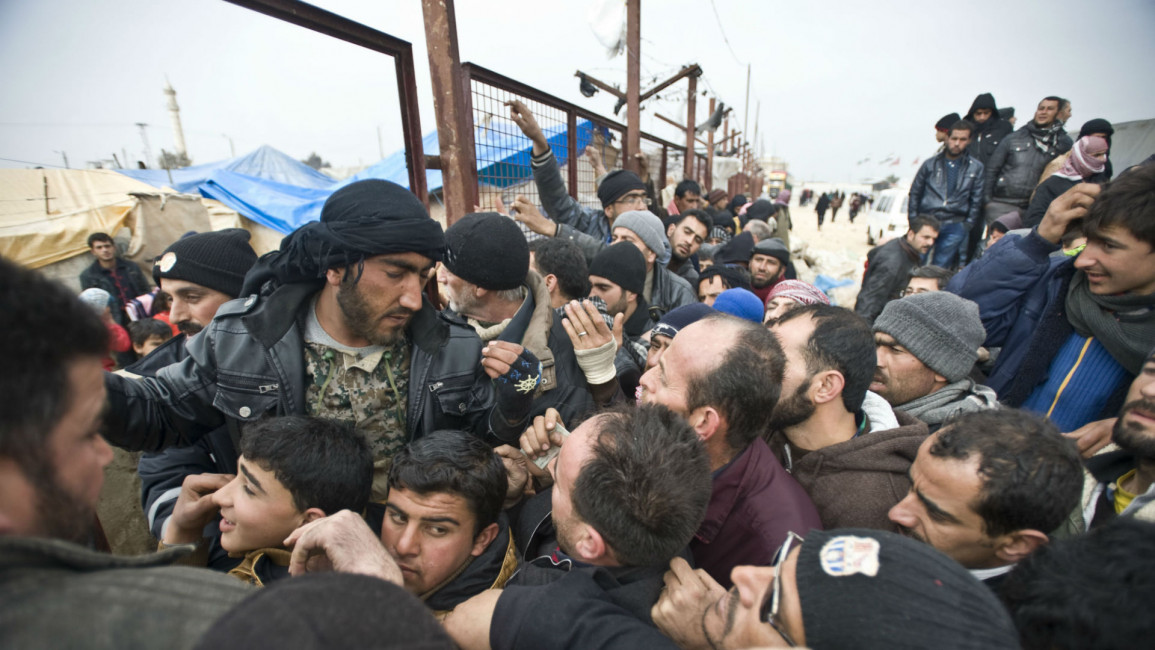
Report: 11.5 percent of Syrians dead or injured
Report: 11.5 percent of Syrians dead or injured
A new report estimates there have been 470,000 casualties of Syria's civil war, with death and displacement 'hollowing out' the country's population.
2 min read
The new estimated death toll is a dramatic increase on the last UN figure [Anadolu]
Five years of civil war have claimed the lives of 470,000 people in Syria, according to a report published by the Syrian Centre for Policy Research (SCPR).
This new figure is a dramatic increase on the UN's most recent estimate of 250,000, which it gave before it stopped collecting statistics 18 months ago.
It is thought that 400,000 of those killed have been direct casualties of war, with the remaining 70,000 having died due to inadequate healthcare services, shortages of food and water, poor sanitation facilities and a severe lack of shelter for those displaced by the conflict.
In total, the number of those killed and injured by the war is amounts to some 11.5 percent of the country's entire pre-war population.
As efforts got underway to enforce a ceasefire, UN High Commissioner for Human Rights Zeid Ra'ad al-Hussein expressed his outrage at the deteriorating situation.
"The warring parties in Syria are constantly sinking to new depths, without apparently caring in the slightest about the death and destruction they are wreaking across the country," he said.
"Women and children, the elderly, the wounded and sick, the people with disabilities, are being used as bargaining chips and cannon-fodder day after day, week after week, month after month. It is a grotesque situation."
Since the conflict broke out in March 2011, Syria has suffered a catastrophic loss of human life that has been accompanied by the crumbling of the country's economy and infrastructure.
According to the SCPR's report, Confronting Fragmentation, the total economic loss between 2011 to the end of 2015 was an estimated $254.7 billion, with unemployment surging from 14.9 percent to 52.9 percent in the same period.
These factors have all contributed to the vulnerability of Syria's people, many of whom are now directly involved in the conflict economy, or are at the mercy of rival factions who have used resource allocation as a means of maintaining loyalty.
Faced with such circumstances, it comes to no surprise that Syria's population has fallen by 21 percent since the outbreak of conflict, with a huge portion of this number being those who have fled to Europe and neighbouring countries.
This new figure is a dramatic increase on the UN's most recent estimate of 250,000, which it gave before it stopped collecting statistics 18 months ago.
It is thought that 400,000 of those killed have been direct casualties of war, with the remaining 70,000 having died due to inadequate healthcare services, shortages of food and water, poor sanitation facilities and a severe lack of shelter for those displaced by the conflict.
In total, the number of those killed and injured by the war is amounts to some 11.5 percent of the country's entire pre-war population.
As efforts got underway to enforce a ceasefire, UN High Commissioner for Human Rights Zeid Ra'ad al-Hussein expressed his outrage at the deteriorating situation.
"The warring parties in Syria are constantly sinking to new depths, without apparently caring in the slightest about the death and destruction they are wreaking across the country," he said.
"Women and children, the elderly, the wounded and sick, the people with disabilities, are being used as bargaining chips and cannon-fodder day after day, week after week, month after month. It is a grotesque situation."
Since the conflict broke out in March 2011, Syria has suffered a catastrophic loss of human life that has been accompanied by the crumbling of the country's economy and infrastructure.
According to the SCPR's report, Confronting Fragmentation, the total economic loss between 2011 to the end of 2015 was an estimated $254.7 billion, with unemployment surging from 14.9 percent to 52.9 percent in the same period.
These factors have all contributed to the vulnerability of Syria's people, many of whom are now directly involved in the conflict economy, or are at the mercy of rival factions who have used resource allocation as a means of maintaining loyalty.
Faced with such circumstances, it comes to no surprise that Syria's population has fallen by 21 percent since the outbreak of conflict, with a huge portion of this number being those who have fled to Europe and neighbouring countries.




